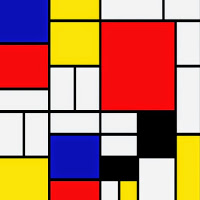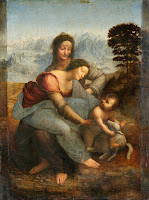The study of Neuroscience and brain is one of the field that has a humongous and countless potentiality of future biology. When it comes to the combination of Neuroscience and Art, the book, The Age of Insight, says that human brain takes a huge part of artistic creativity to produce great artworks. In other words, it means that all art follows the rules of visual art. The pioneer of the Neuro-aesthetist, Semir Zeki, indicates all the artists as tacit and potential Neuroscientists giving us an example of Mondrian's art that based on straight line before the discovery of brain cell that only reacts with straight lines. He believes that the artistic intuition is a result of internal and instinctive appreciation of human brain activities.
 |
| Mondrian's Paintings |
In the lecture, professor Vesna explains main two concept of brain activity; consciousness and unconsciousness. And then, she introduces two prominent psychologists, Jung and Freud. Even though two scholars have different point of view toward details about consciousness and unconsciousness, both claim the artistic expression is definitely related to a certain neurological activities. Especially, Freud argues that artists' paintings or any other forms of artworks are the result of unfulfilled need. Unconsciously, individual artists put their hidden desires or blurred memories of their early years(childhood years) into the drawings.
Leonardo Da Vinci could be the best example of an artist that explicitly expressed his unconscious desires through his art. He was born as a illegitimate child in noble family and raised under step mother. His entire childhood was full of lack of fatherhood. He kept dreaming of an eagle that pecks his lips; which implies the passive sexual activities. Actually, the lack of the father led to the obsession for motherhood and homosexual inclination. He would have picked some pretty-boys as pupils by their appearance rather than drawing skills. Also, he had drawn "Mona Lisa", and "The Virgin and Child with St. Anne" during the highlight of his career trying to reproduce the benevolent smile of mother in the memory.
Based on the theories, art has been developed and created by many painters in many types. In modern days, Art Therapy is another form of collaboration of brain and art. Art therapy is one type of therapy to treat patients emotions and internal anxieties through drawing something, which many experts believe that the art is the main medium that human beings can express themselves. That is originally derived from both theories by Freud and Jung. According to Freud's therapy method, patients are required to draw anything that comes up with their minds and then, they get to explore their unconsciousness in the drawings. On the other hand, Jung emphasizes the connection of the drawing from our unconsciousness to our consciousness eventually, which can be accomplished through conversation about the drawing.
Citations:
Huang, Mengfei. "The Neuroscience of Art." The Neuroscience of Art (n.d.): 24-26. Stanford University. Web. 17 May 2015.
Jung and Freud 1. Youtube. N.p., 11 Nov. 2012. Web. 17 May 2015. <https://youtu.be/_OXGd_mHut4>.
Jungian Art Therapist. Youtube. N.p., 13 Nov. 2012. Web. 17 May 2015. <https://youtu.be/BBjVB3SalBk>.
Kandel, Eric R. The Age of Insight: The Quest to Understand the Unconscious in Art, Mind, and Brain: From Vienna 1900 to the Present. New York: Random House, 2012. Print.
Vesna, Victoria. Lecture. “Neuroscience-pt1.” 17 May 2015. <https://youtu.be/TzXjNbKDkYI>
Vesna, Victoria. Lecture. “Neuroscience-pt2.” 17 May 2015. <https://youtu.be/TFv4owX3MZo>
What Is Art Therapy? Youtube. Southwestern College - Santa Fe, 27 May 2013. Web. 17 May 2015. <https://youtu.be/E5tgfOBqwMk>.



No comments:
Post a Comment